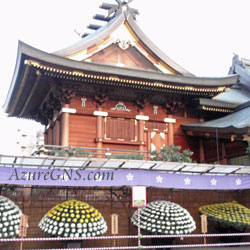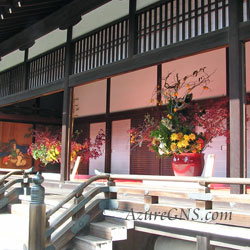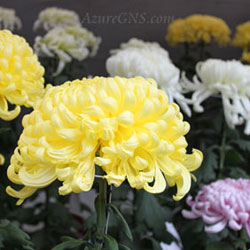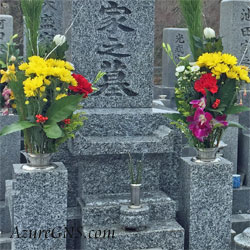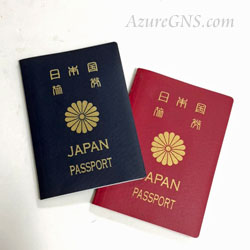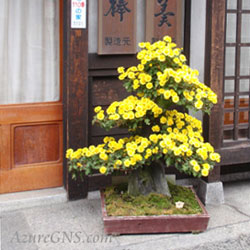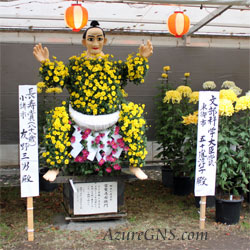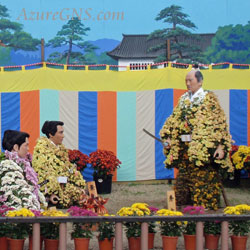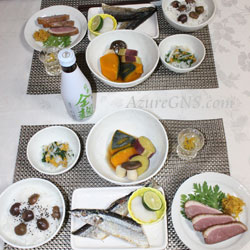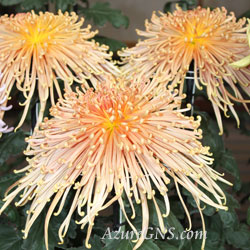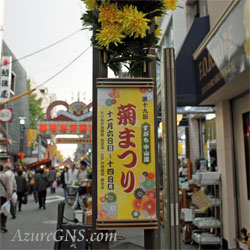(9月9日)
Kiku-no-sekku (Choyo);
The Chrysanthemum Festival
(September 9th)
●重陽;菊の節句 Choyo-no-sekku; the Chrysanthemum Festival
●菊 chrysanthemum; mum
●菊の御紋 the Imperial crest composed of sixteen open; chrysanthemum petals
●菊花展 a chrysanthemum exhibition
●菊の品評会 a chrysanthemum competitive [prize] show,
a chrysanthemum fair
●菊人形 a chrysanthemum figure
●菊人形展 a chrysanthemum figure exhibition; a chrysanthemum doll exhibition
●食用菊 an edible chrysanthemum
●旧暦 the lunar calendar
●縁起の良い;めでたい auspicious
●縁起の悪い;不吉な inauspicious
●不老長寿 perpetual youth and longevity
◆重陽の節句は陰暦の9月9日(新暦では10月9日)で、菊の節句とも呼ばれます。
Choyo-no-sekku falls on September 9th in the lunar calendar (October 9th in the solar calendar), and it is also called Kiku-no-sekku (the Chrysanthemum Festival).
◆古来中国の陰陽思想では、偶数は陰(縁起が悪い)、奇数は陽(縁起が良い)とみなされています。
Even numbers are considered to be Yin (inauspicious), and odd numbers are considered to be Yang (auspicious) in the concept of Yin and Yang in ancient China.
◆一桁で最も大きな陽数である9が重なる9月9日を、文字通り重陽と呼びます。
The number 9 is the highest single-digit Yang number, and September (the ninth month) 9th is literally called Choyo (double Yang).
◆平安時代(794-1191)、宮中で重陽の節句を祝うようになりました。
In the Heian era (794-1191), Choyo-no-sekku began to be celebrated at the Imperial Court.
◆重陽の節句の前日、旧暦の9月8日に貴族達は菊の花を真綿で覆いました。
On September 8th, the day before Choyo-no-sekku, aristocrats covered flowers of chrysanthemums with cotton.
◆翌朝、香りが移り、露で湿った綿で顔や体を拭いながら、不老長寿を祈りました。
On the next morning, they wiped their faces and bodies with the cotton containing the scent of the flowers and moisture of the dew while praying for perpetual youth and longevity.
◆そしてちょうど重陽の節句の頃に美しく咲く菊を愛でたり、菊を題材に和歌を詠んだり、菊を日本酒に浮かべた菊酒を飲みました。
Chrysanthemums were at their best around Choyo-no-sekku, so they appreciated chrysanthemums, made Waka (a Japanese traditional poem of a 5-7-5-7-7 syllable) about chrysanthemums and drank Kiku-zake (sake with floating chrysanthemums).
◆宮中での重陽の節句にゆかりのある菊花壇展は、毎年11月1日から15日まで東京都新宿区の新宿御苑で開催されています。
Kiku-kadanten (the chrysanthemum exhibition), which has a connection to Choyo-no-sekku in the Imperial Court, is held in Shinjuku Gyoen Park in Shinjuku Ward, Tokyo, from November 1st to the 15th every year.
◆多くの神社仏閣では今でも重陽の節句の祭事が行われています。
Even now, rites and festivals of Choyo-no-sekku are still performed in many shrines and temples.
◆主に九州でくんちと呼ばれる収穫に感謝する秋祭りは、重陽の日に行われます。
Kunchi is an autumn festival for the appreciation of the autumn harvest held on Choyo-no-hi.
◆9日は「くんち」という読み方もあるので、お祭りのくんちの語源になったという説もあります。
According to one theory, the origin of the name of Kunchi is the date of “the 9th” as one of its pronunciations is “Kunchi” in Japanese.
◆9月15日が敬老の日として1966年(昭和41年)に国民の祝日に制定されたのは、不老長寿を願う重陽の節句と関係があります。
In 1966 (Showa 41st yr), September 15th was established as a national holiday under the new name of Keiro-no-hi, Respect for the Aged Day, because the day was near Choyo-no-sekku, which was the festival for perpetual youth and longevity.
◆一方、ヨーロッパやアジアの国々同様に、菊は哀悼や追悼を表す象徴的な花でもあり、お葬式やお墓にたびたび供えられます。
On the other hand, chrysanthemums are also symbolic flowers to express condolences and sympathy in some countries like in Europe and Asia, so they are often offered in funerals and to graves.
◆菊は桜と並び日本の代表的な花で、中国より平安時代に観賞用と薬用として伝来しました。
Chrysanthemums as well as cherry blossoms are representative flowers in Japan, and they were introduced into Japan from China in the Heian era for appreciation and medicine.
◆日本の皇室の御紋章は1869年(明治2年)より、十六八重表菊になっています。
The Imperial Seal of Japan has been a front set of a 16 petal-chrysanthemum with double rows since 1869 (Meiji 2nd yr).
◆日本のパスポートの表面には一重の十六表菊が金色で印刷されています。
A front set of a 16-petal Chrysanthemum with single row is printed on Japanese passports in gold color.
◆50円玉の表には菊がデザインされています。
Chrysanthemum designs can be seen on the front side of 50-yen coins.
◆菊を育てたり、品種改良したりする技術は、江戸時代(1603-1867)に職人や花の愛好家により著しく発達しました。
In the Edo period (1603-1867), techniques of cultivation and improvement of breeds were remarkably developed by gardeners and flower lovers.
◆その頃から、菊合わせと呼ばれる菊の品評会がしばしば開かれ、盛んに競い合いました。
Around that time, they often held Kiku-awase (a chrysanthemum competitive show) and vied with each other enthusiastically.
◆それ以来、毎年、秋には各地で菊の品評会、または菊花展や菊まつりが開かれ、さまざまな品種が出展されます。
Since then, chrysanthemum competitive shows, exhibitions or festivals have been held all around Japan every autumn, and many new varieties are exhibited.
◆大きな展示会では、内閣総理大臣賞、様々な大臣賞、知事賞、市長賞などの賞が設けられています。
In some big exhibitions, there are prizes such as the Prime Minister Prize, the prizes of various ministers, the Governor Prize, and the Mayor Prize.
◆菊人形は江戸後期に江戸で始まりました。
Kiku-ningyo (chrysanthemum figure) started in Edo (ancient Tokyo) in the late Edo period.
◆顔や手足は蝋人形と同じように作られ、ほとんどが等身大です。
Their faces, hands, and feet are made in the same way as wax dolls, and most of them are life-size figures.
◆竹、木材、藁、紐、そして最近ではワイヤーなどで骨組みを作り、根がついたままの菊を衣類のように付けていきます。
Their body structures are made of bamboo, wood, straw, rope, and recently wire, and chrysanthemums with roots are placed on them like clothes.
◆「平家物語」、「源氏物語」、歌舞伎、毎年のNHK大河ドラマ(毎年、一年間放送している日本の歴史を題材にした連続ドラマ)などの歴史絵巻がテーマになることが多いです。
The themes are often historical stories like “Tale of the Heike”, “Tale of the Genji”, Kabuki, or the year-long “NHK Taiga Drama” (an annual, year-long serial TV drama of Japanese historical fiction).
◆菊は古くから食用になっています。
People have also enjoyed eating chrysanthemums since traditional times.
◆ただし全ての菊を食べることができるわけではなく、食用に苦みや匂いを抑えて作られた食用菊のみ食べられます。
However, we cannot eat all chrysanthemums, but only edible ones which have less scent and bitterness.
◆花は刺身の飾りや酢の物、葉はすき焼きの具、おひたし、天ぷらなどにして食べられます。
The flowers are used as decorations for sashimi (sliced raw fish) or eaten in vinegar, and the leaves are eaten in sukiyaki, boiled and eaten with soy sauce, or cooked as tempura.
◆庶民が菊を食べるようになったのは、江戸時代になってからです。
It was in the Edo era that common people began to eat them.
(より詳しい情報は「菊花展と菊人形展」、「食用菊」をご覧下さい。)
(Please see “The Chrysanthemum Exhibitions and the Chrysanthemum Figure Exhibitions” and “The Edible Chrysanthemums” for further information.)
Copyright (C) Azure Global Network Services. All Rights Reserved.

